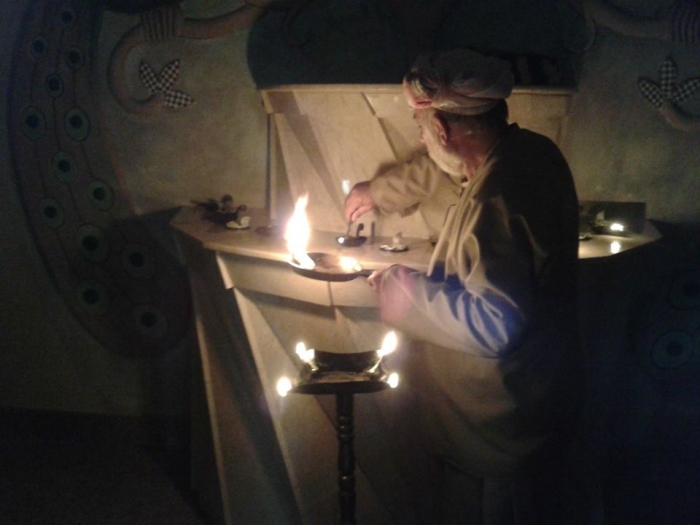The 'Sacred Books' 2. Yezidism – its background observances and textual tradition

Philip G. Kreyenbroek
To these arguments Mingana could have added Isma'il Beg's emphatic claim that the Yezidis have no scriptures, and the ipsissima verba of the Jilwe: "I guide without a scripture". There was also the question of the type of Kurdish used in Anastase's version of the works. As Edmonds realised, far from being an archaic forai of Kurdish, the language of the texts is modern Sorani—a dialect spoken in an area of Kurdistan where there has been no known Yezidi presence since the sixteenth century and which probably did not develop a written literature until the end of the eighteenth Moreover, to the present day no Yezidi in good standing has publicly acknowledged that these works represent a genuine scriptural tradition
Mingana's conclusions were later challenged by Furlani, Implicitly admitting that none of his other counter-arguments constituted proof of the ancient origin of the extant texts, the Italian scholar advanced the following as his final and, he thought, conclusive argument;
The Kurdish text first published by Anastase is written in a medieval Kurdish dialect that is no longer spoken in our time.The Kurdish dialect of the books demonstrates in a definitive and conclusive manner that these are authentic, i.e., they cannot have been written long after the end of the Middle Ages, or the beginning of the modem age.
Since, as we saw, Furlani's fundamental contention was based on a misunderstanding, it might seem easy to dismiss the 'Sacred Books' altogether, concluding that the frantic interest of Western researchers probably led some figure of doubtful integrity to produce clever forgeries. There are several arguments, however, to suggest that such a solution would be too simple. First of all, a number of travellers' accounts100 show that at least a section of the Yezidi community believes that one or more Sacred Books exist, although there is no clear indication as to what they may contain. Moreover, both the names Jilwe and MeshefResh are mentioned in accounts by authors who wrote long before the question became an issue, or who denied the existence of written Sacred Books altogether, as in the case of Ismail Beg. A document drawn up by an eighteenth-century Mufti contains the following statement: "Adultery is lawful in their eyes, if it is committed with the assent (of the husband). Hie person who asserts this has told me that he has seen it written in a book called Jilwe, which they attribute to Sheykh Adi." Empson mentions a Dr Forbes who, "when on a visit to the Sinjar in 1838, heard of the Black Book [Meshef Resh], and was told that Sheykh Adi was the author." While these statements prove that works known as Jilwe and Meshef Resh formed part of the religious tradition of the Yezidis, they may in fact have referred to texts which did not exist in written form. Either the Mufti or his informant could easily have substituted the notion of a written book for the unfamiliar one of an oral text. Ismail Beg's statement that the Yezidis have no scripture, God's Word being "handed down from father to son according to the tradition of "Gyli-e Azim" [i.e. the Jilwe],"l(}4 shows that a son of the Princely dynasty thought of the Jilwe as an orally transmitted religious text. More recently, in 1968, Professor Joyce Blau visited Jebel Sinjar and recorded a text which her informant called the Meshef Resh. The recording does not contain the text of the Meshef 3.% it is known to us—it largely consists of an episode of Yezidi legendary history — but the informant's assertion can confidently be taken to imply that the Meshef Resh was' thought of locally as an oral text which could be recited like other such texts. That there was also a tradition associating the text with a written book is indicated by the fact that Professor Blau was shown a blank exercise book, which was said to be the Meshef Resh.
The notion that all extant versions of the 'Sacred Books' derive from an oral tradition receives further support from the type of variants that occur. Although the wording of parallel passages is largely similar, some texts contain passages which are omitted in others. Grave scribal carelessness of this kind would be unexpected in the case of a Sacred Book known to be of great interest to the prospective purchaser, but such phenomena are known to occur frequently in oral traditions. Furthermore, Ishak of Bartella's account of the creation of the world corresponds almost entirely with a passage that occurs, somewhat curiously towards the end of the Meshef Resh, partly summing up what has been expounded in detail before, and adding a new account of the creative activities of the Angels. Ishak's version of the latter part of the passage is more complete than its counterpart in any variant of the Meshef, but it is closer to Anastase/Bittner's version, which has never been attributed to Jeremiah Shamir, than to that of Browne/Guest.10^ Unless one were to invoke some remarkably subtle forger's ploy, this seems to contradict Mingana's thesis that Shamir was the author of both the work attributed to Istiak and the manuscript used by Browne. It would, on the other hand, be wholly consistent with the theory that Qewwals were trained to remember both texts separately, the shorter text being used at times to elucidate the longer one. This may have led to the inclusion of both texts in the written version of the Meshef, while Ishak's informant regarded the shorter text as sufficient. Furthermore, the essential elements of the Cosmogony as set out in the Meshef Resh, are confirmed by the contents of the Qew/s, about whose authenticity there can be no doubt. The information contained in that text can further be shown to go back to an ancient, pre-Islamic tradition about which neither Shamir nor any of his contemporaries could possibly have known. These considerations can be regarded as additional evidence that the Meshef at least represents a genuine tradition. This in turn makes it seem likely that the Jilwe is also to be regarded as authentic. Both texts may have been taught to Qewwals and other 'men of religion' as part of their training.
It seems probable, therefore, that these texts were held to contain the essential teachings of the founders of the faith as they were once laid down in written texts of the same name. The Jilwe proclaims the sovereignty and omnipotence of Melek Tawus, while the Meshef Resh contains accounts of the Cosmogony, the origins of mankind, the ancient history of the sect, and a list of prohibitions.
Tags: #yazidisinfo #yazidi #yezidi #aboutyezidi
The 'Sacred Books' 2. Yezidism – its background observances and textual tradition

Philip G. Kreyenbroek
To these arguments Mingana could have added Isma'il Beg's emphatic claim that the Yezidis have no scriptures, and the ipsissima verba of the Jilwe: "I guide without a scripture". There was also the question of the type of Kurdish used in Anastase's version of the works. As Edmonds realised, far from being an archaic forai of Kurdish, the language of the texts is modern Sorani—a dialect spoken in an area of Kurdistan where there has been no known Yezidi presence since the sixteenth century and which probably did not develop a written literature until the end of the eighteenth Moreover, to the present day no Yezidi in good standing has publicly acknowledged that these works represent a genuine scriptural tradition
Mingana's conclusions were later challenged by Furlani, Implicitly admitting that none of his other counter-arguments constituted proof of the ancient origin of the extant texts, the Italian scholar advanced the following as his final and, he thought, conclusive argument;
The Kurdish text first published by Anastase is written in a medieval Kurdish dialect that is no longer spoken in our time.The Kurdish dialect of the books demonstrates in a definitive and conclusive manner that these are authentic, i.e., they cannot have been written long after the end of the Middle Ages, or the beginning of the modem age.
Since, as we saw, Furlani's fundamental contention was based on a misunderstanding, it might seem easy to dismiss the 'Sacred Books' altogether, concluding that the frantic interest of Western researchers probably led some figure of doubtful integrity to produce clever forgeries. There are several arguments, however, to suggest that such a solution would be too simple. First of all, a number of travellers' accounts100 show that at least a section of the Yezidi community believes that one or more Sacred Books exist, although there is no clear indication as to what they may contain. Moreover, both the names Jilwe and MeshefResh are mentioned in accounts by authors who wrote long before the question became an issue, or who denied the existence of written Sacred Books altogether, as in the case of Ismail Beg. A document drawn up by an eighteenth-century Mufti contains the following statement: "Adultery is lawful in their eyes, if it is committed with the assent (of the husband). Hie person who asserts this has told me that he has seen it written in a book called Jilwe, which they attribute to Sheykh Adi." Empson mentions a Dr Forbes who, "when on a visit to the Sinjar in 1838, heard of the Black Book [Meshef Resh], and was told that Sheykh Adi was the author." While these statements prove that works known as Jilwe and Meshef Resh formed part of the religious tradition of the Yezidis, they may in fact have referred to texts which did not exist in written form. Either the Mufti or his informant could easily have substituted the notion of a written book for the unfamiliar one of an oral text. Ismail Beg's statement that the Yezidis have no scripture, God's Word being "handed down from father to son according to the tradition of "Gyli-e Azim" [i.e. the Jilwe],"l(}4 shows that a son of the Princely dynasty thought of the Jilwe as an orally transmitted religious text. More recently, in 1968, Professor Joyce Blau visited Jebel Sinjar and recorded a text which her informant called the Meshef Resh. The recording does not contain the text of the Meshef 3.% it is known to us—it largely consists of an episode of Yezidi legendary history — but the informant's assertion can confidently be taken to imply that the Meshef Resh was' thought of locally as an oral text which could be recited like other such texts. That there was also a tradition associating the text with a written book is indicated by the fact that Professor Blau was shown a blank exercise book, which was said to be the Meshef Resh.
The notion that all extant versions of the 'Sacred Books' derive from an oral tradition receives further support from the type of variants that occur. Although the wording of parallel passages is largely similar, some texts contain passages which are omitted in others. Grave scribal carelessness of this kind would be unexpected in the case of a Sacred Book known to be of great interest to the prospective purchaser, but such phenomena are known to occur frequently in oral traditions. Furthermore, Ishak of Bartella's account of the creation of the world corresponds almost entirely with a passage that occurs, somewhat curiously towards the end of the Meshef Resh, partly summing up what has been expounded in detail before, and adding a new account of the creative activities of the Angels. Ishak's version of the latter part of the passage is more complete than its counterpart in any variant of the Meshef, but it is closer to Anastase/Bittner's version, which has never been attributed to Jeremiah Shamir, than to that of Browne/Guest.10^ Unless one were to invoke some remarkably subtle forger's ploy, this seems to contradict Mingana's thesis that Shamir was the author of both the work attributed to Istiak and the manuscript used by Browne. It would, on the other hand, be wholly consistent with the theory that Qewwals were trained to remember both texts separately, the shorter text being used at times to elucidate the longer one. This may have led to the inclusion of both texts in the written version of the Meshef, while Ishak's informant regarded the shorter text as sufficient. Furthermore, the essential elements of the Cosmogony as set out in the Meshef Resh, are confirmed by the contents of the Qew/s, about whose authenticity there can be no doubt. The information contained in that text can further be shown to go back to an ancient, pre-Islamic tradition about which neither Shamir nor any of his contemporaries could possibly have known. These considerations can be regarded as additional evidence that the Meshef at least represents a genuine tradition. This in turn makes it seem likely that the Jilwe is also to be regarded as authentic. Both texts may have been taught to Qewwals and other 'men of religion' as part of their training.
It seems probable, therefore, that these texts were held to contain the essential teachings of the founders of the faith as they were once laid down in written texts of the same name. The Jilwe proclaims the sovereignty and omnipotence of Melek Tawus, while the Meshef Resh contains accounts of the Cosmogony, the origins of mankind, the ancient history of the sect, and a list of prohibitions.
Tags: #yazidisinfo #yazidi #yezidi #aboutyezidi

























